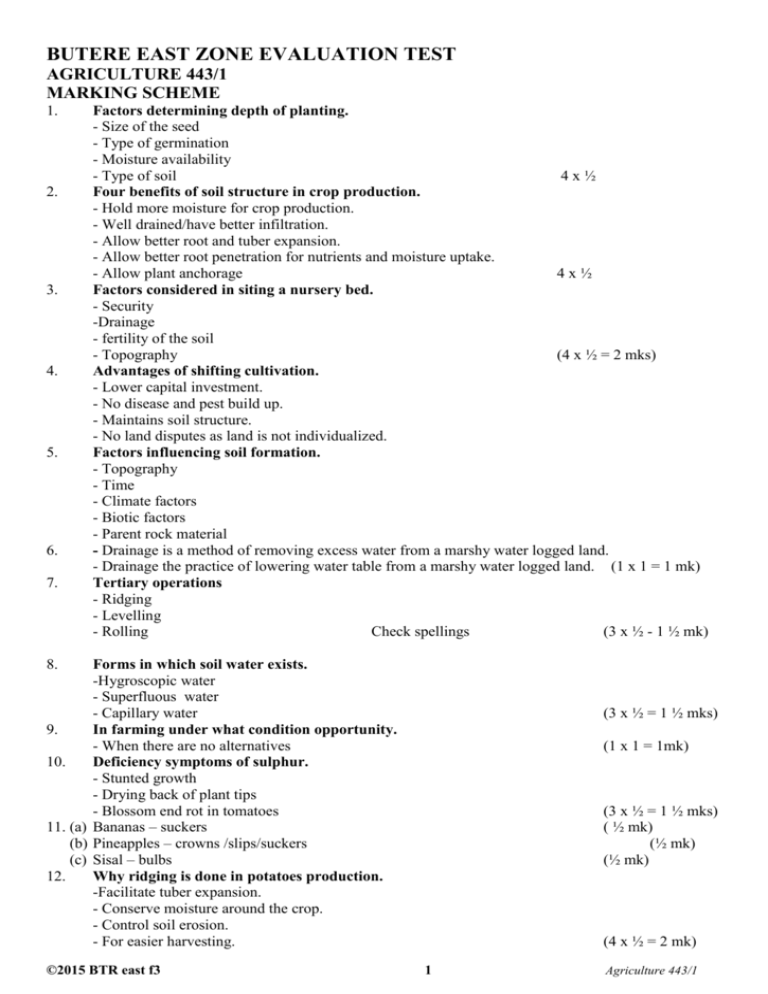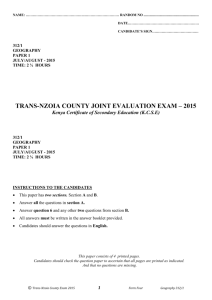agric 1 a
advertisement

BUTERE EAST ZONE EVALUATION TEST AGRICULTURE 443/1 MARKING SCHEME 1. 2. 3. 4. 5. 6. 7. Factors determining depth of planting. - Size of the seed - Type of germination - Moisture availability - Type of soil 4x½ Four benefits of soil structure in crop production. - Hold more moisture for crop production. - Well drained/have better infiltration. - Allow better root and tuber expansion. - Allow better root penetration for nutrients and moisture uptake. - Allow plant anchorage 4x½ Factors considered in siting a nursery bed. - Security -Drainage - fertility of the soil - Topography (4 x ½ = 2 mks) Advantages of shifting cultivation. - Lower capital investment. - No disease and pest build up. - Maintains soil structure. - No land disputes as land is not individualized. Factors influencing soil formation. - Topography - Time - Climate factors - Biotic factors - Parent rock material - Drainage is a method of removing excess water from a marshy water logged land. - Drainage the practice of lowering water table from a marshy water logged land. (1 x 1 = 1 mk) Tertiary operations - Ridging - Levelling - Rolling Check spellings (3 x ½ - 1 ½ mk) 8. Forms in which soil water exists. -Hygroscopic water - Superfluous water - Capillary water 9. In farming under what condition opportunity. - When there are no alternatives 10. Deficiency symptoms of sulphur. - Stunted growth - Drying back of plant tips - Blossom end rot in tomatoes 11. (a) Bananas – suckers (b) Pineapples – crowns /slips/suckers (c) Sisal – bulbs 12. Why ridging is done in potatoes production. -Facilitate tuber expansion. - Conserve moisture around the crop. - Control soil erosion. - For easier harvesting. ©2015 BTR east f3 (3 x ½ = 1 ½ mks) (1 x 1 = 1mk) (3 x ½ = 1 ½ mks) ( ½ mk) (½ mk) (½ mk) (4 x ½ = 2 mk) 1 Agriculture 443/1 13. Reasons for pruning - Allow enough light penetration - Improve quality produce - Reduce pests and diseases - Enable effective use of chemical sprays - Train the crop to have the required shape (4 x ½ = 2 mks) 14. Organic farming is the growing of crops and raising of livestock without the use of agro chemicals. (1 x 1) 15. (i) Pricking out – Enable seedling to grow vigorously and health/ to avoid overcrowding in the primary nursery (ii) Hardening off – to enable seedlings get used to actual field condition. (2 x 1 = 2 mks) 16. Problems of hard pan - Poor aeration - Prevent root penetration - Leads to accumulation of salts - Hinders activation of soil organisms - Poor water infiltration/water logging (4 x ½ = 2 mks) 17. - Introduce nitrogen fixing bacterial to fix nitrogen for the plant. - To promote nitrogen fixation prior to planting. (2 x ½ = 1 mk 18. Importance of Afforestation - Control soil erosion - Improves drainage of swampy area - Creating of suitable micro-climate - Adds organic matter through leaf fall which decompose adding nutrients. (4 x ½ = 2 mks) 19. Types of inventory record. -Consumable goods inventory - Permanent goods inventory. (2 x ½ = 1 mk) SECTION B 20. (A) Thorn appl (Datura stramonium) (1 mk) (B) – Compete with crops for nutrients and space and poisonous to livestock. (2x1= 2mks) (C) – Leaf angle of inclination - Nature of rooting system - Location of growing points (2x1= 2mks) - Presence or absence of underground/rooting structure - Crop differential height (4 x ½ = 2 mks) 21. 20 kg N is contained in 100 kg CAN x kg = 150 kg CAN x = 150 kg CAN x 20 kg ( ½ mk) 100 kg CAN = 30 kg N/ha ( ½ mk) 22. (a) – Broad based terrace (1 x 1= 1 mk) (b) – M – drain/channel (1x1=1mk) (c) – Costly to construct since heavy machines are used. (1 x1 = 1mk) 23. (a) – Roof catchment (1 x 1 = 1mk) (b) – Rainfall intensity - Duration of rainfall - Surface area of the roof (2 x 1= 2 mks) (c) – repair the leaking parts - Regularly wash and remove the sediments - Paint the iron sheet tank to control rusting. (1 x 1 = 1 mk) (d) - Ponds, Drums (1 x 1 = 1mk) (e) Procedure for soil sampling - Clear the vegetation - Make a vertical cut to 15 cm to 30 cm for crop land or 5 cm for pasture land. - Take a slice from the vertical cut or use a soil anger to scoop out the soil. ©2015 BTR east f3 2 Agriculture 443/1 - Put the soil in a clearly labelled polythene bag. - Repeat the above procedure in a different locations according to the method of sampling. SECTION C: (40 MARKS) 24. a). Reasons for minimum tillage - Reduce cost of ploughing. - Control soil erosion. - Maintain soil structure. - Prevent disturbance of roots. - Prevent exposure of humus to adverse conditions. - Conserve soil structure. (1 x 6 = 6 mks) b). Importance of crop rotation - Improve soil fertility. - Control of soil erosion - Improve soil structure - Control of weeds - Central of soil borne pests and diseases build up. - Maximum utilization of nutrients. (6 x 1 = 6 mks) c). Benefits of primary cultivation - Makes subsequent operations easier. - Facilitates aeration and water infiltration in the soil. - It controls weeds by burying or uprooting them. - Enables penetration of crop roots. - Controls pests and diseases by exposing them to the scorching sun or predators. (4 x 1 = 4 mks) d). Importance of organic matter. - Prevents nutrients leaching - Reduces toxity of the soil. - Improves soil fertility when they decompose and release nutrients - Encourages microbial activities - Improves water infiltration and retention capacity. - Moderates/buffers soil P.H by preventing rapid chemical changes. (4 x 1 = 4 mks) 25. (a) Cultural method of controlling pests. - Observing field hygiene - Destruction of alternate host - Planting resistance varieties of crops - Proper land preparation - Timely planting - Use of clean planting material - Practicing closed season - Crop rotation - Pruning - Proper spacing Each point well explained = 1 mk (10 x 1 = 10 mks) (b) Biotic factors influencing agriculture. (i) Pathogens – they cause diseases to livestock, crop causing death of both livestock and crops - reduces quality and quantity of agricultural products. (ii) Pollinators – They aid in pollination thus contributing to the development of new varieties of crops. (iii) Predator – Animals that prey on others, some help to control pests by feeding on them. (iv) Nitrogen fixing bacteria – help in fixation of nitrogen in the soil. (5 x 2 = 10 mks) 26. (a) (i) Planting - Make continuous drills 30 – 40 cm apart. - Apply DSP in the drills at the rate of 90 kg/ha. - Mix the fertilizer well with the soil. ©2015 BTR east f3 3 Agriculture 443/1 - Place the seeds in the drill at the rate of 5 – 6 kg/ha - Cover the seeds lightly, then carry out rolling. (5 x 1 = 5 mks) (ii) Field Management - Thin two weeks after germination to attain a distance of 5 cm – 8 cm. - Keep the field free of weeds - Earth up during weeding - Top dress with CAN at 60 kg/ha - Carry out irrigation during dry conditions. - Control pests and diseases using appropriate chemicals. (5 x 1 = 5 mks) (b) Problems associated with land fragmentation. - Supervision of rains units of land is a difficult. - Time wasted in traveling to various units of land. - Difficult for a farmer to follow a sound farm plan. - Difficult to control weeds, pests and diseases effectively. - Hard to obtain or administer agricultural services. - Difficult to implement soil conservation measures. - Difficult to mechanism, (not economical to farmers) - Difficult to construct permanent structures. - There is wastage of money travelling to various units. - Under this conditions agricultural productivity remains poor resulting in low living standards of living. - Difficult to control parasites and diseases in livestock as animal move from one field to the other (10 x 1 = 10 mks) ©2015 BTR east f3 4 Agriculture 443/1





